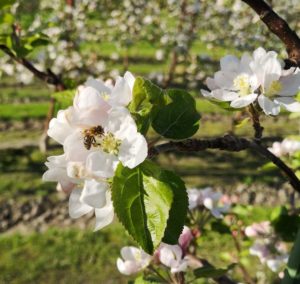Long-time no see! I’m back from field and in the middle of my final period of bachelor’s exams. I’m glad you choose to continue reading and that I could keep your interest. And for all new readers, welcome!
As promised, I will now introduce you to the exciting research project “APPLECORe” that I get to be involved with. Did you manage to guess the name? If you did, I’m quite impressed!
The name “APPLECORe” stands for “Assessment of Pollination Provisioning in agricultural Landscapes and the roles of Environment and Climate on Resilience”
The «APPLECORe» project is led by NINA and carried out in collaboration with the research institutions NIBIO, NORCE, University of Bergen and University of Essex. In addition, the business partners Landbruksrådgivning Vest og Viken, the government agencies Miljødirektoratet, Landbruksdirektoratet, and Statsforvalteren in Vestland, Oslo and Viken is also involved in the project.
The goal of «APPLECORe» is to find out how efficient the different pollinators, both wild and domesticated, are at transferring pollen between crops in fruit fields. Apple trees have a limited ability to perform self-pollination and are thus dependent on the insects for gene-transmission and reproduction, and higher yields of production are obtained when pollen is transferred between apple trees that are not closely related.
Climate change threatens to change the growing season of fruit and vegetables in Norway, and this could potentially lead to a mismatch between when pollinators start pollinating and when crops bloom. Thus, it is important to uncover the proportion of the pollination the wild pollinators perform (solitary bees, bumblebees, flies, beetles), as during the shifting climatic conditions it will be crucial to facilitate and maintain a pollinator community with a certain diversity to ensure that there are pollinators present when the crops are in bloom. In addition, studies have also shown that wild pollinators may account for as much as 20 % of the total pollination service in a similar system, and that they increase yield, even at high densities of honeybees present. This shows that wild pollinators may play an important role in our agricultural system, and there is a need for more knowledge about them, which is what APPLECORe wants to achieve.
Traditionally, the western Honeybee (Apis Mellifera) has been managed to ensure pollination of the crops, and beekeepers rent out their cubes to the fruit farmers. But Honeybees need high temperatures to be active and start pollinating quite late in the spring. Thus, next year APPLECORe will introduce the solitary Mason Bee (Osmia Bicornis). This bee is found naturally in Norway, and is known to be an effective pollinator that starts the pollinator job earlier in the year. The Mason Bee can potentially contribute as a supplement to the wild pollinators and the domesticated Honeybees.
«APPLECORe» is funded by “Grofondet” and on their page you can read more about the project (NB: Norwegian). http://www.grofondet.no/aktuelle-prosjekter/applecore-skjotsel-av-villbier-i-fruktproduksjon/
The project has two parallel field sites, one on the west-coast of Norway in Lofthus (Hardanger) and one in Svelvik (Drammen) located east. I have been part of the field team on the latter, which means I got to travel a bit!
– Curious about the method? In the next blog post I will tell you about the field set-up. Stay tuned!




